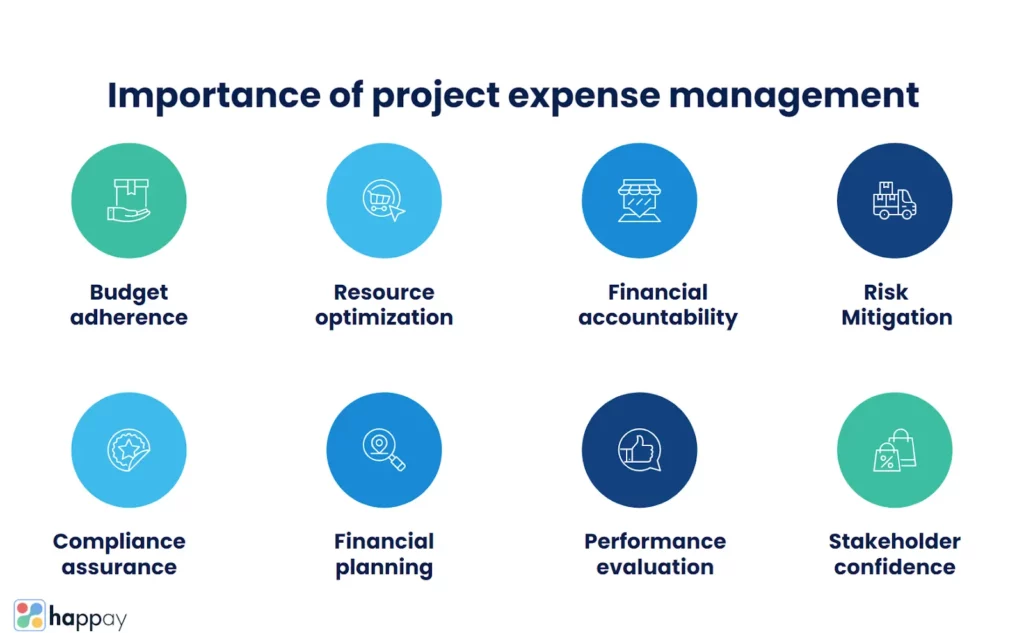Last Updated on November 28, 2025
Efficient management of project expenses (PEM) is pivotal in determining a project’s success.
According to the Project Cost Management Statistics of 2024, 55% of project managers attribute budget overruns as a reason for project failure. Alarmingly, statistics indicate that one in six projects experiences a cost overrun of 200%.
This news is certainly unsettling for companies, as cost overruns impact their margins and hinder the execution of future projects, highlighting the prominence of project expense management across domains.
This article delves into the intricacies of project expense management, its importance, and implementation.
Suggested Reads: Expense Management
Definition and importance of project expense management
Project Expense Management (PEM) is the systematic process of planning, tracking, and controlling expenses throughout the life cycle of a specific project within the approved budget. PEM is critical in determining whether the project will yield a profit or incur losses.

Here are key aspects highlighting the importance of PEM.
- Budget adherence ensures projects stay within allocated budgets
- Resource optimization allocates resources efficiently based on real-time expense data
- Financial accountability establishes parameters for project spending
- Risk mitigation identifies and addresses financial risks early
- Compliance assurance ensures adherence to policies and regulations
- Financial planning creates a baseline for project cost control
- Performance evaluation facilitates post-project analysis and leverages historical data for future expense management
- Stakeholder confidence builds trust among stakeholders
Gaining insight into the various components of project expense management is essential for optimizing its advantages.
Quick read: 15 Best Expense Management Software in India
Key components of project expense management
The project expense management process begins during the project’s planning phase and continues throughout its duration. Here are the key components in the lifecycle of a project.
Budgeting and planning
Budget determination is critical as it defines the cost baseline to measure and control project performance. To establish a suitable budget, the following project documents are mandatory.
- Cost management plan
It provides guidelines to structure the expenditures throughout the project. It is prepared using a project charter, which identifies the approvals required for the financial resources, a schedule management plan highlighting the procedures for developing and monitoring the schedule, and a risk management plan to identify and establish risk management processes to manage risks.
- Project resources plan
It identifies all necessary resources, such as employees, contractors, technology, facilities, and materials. Resource planning is coordinated with the project scope and work breakdown structure to split the project development into easily manageable tasks.
- Cost estimation plan
Determines the cumulative costs of all the resources to accomplish the project. It is based on the project schedule and the duration of usage of individual resources. The plan must consider potential variations such as natural disasters, inflation, or accidents.
An adequate budget includes the approved time-phased funding, including contingency reserves for the project.
Expense tracking and reporting
Expense tracking and reporting involve systematic monitoring and documentation of all project-related expenses. The purpose is to identify cost variances from the cost baseline.
Organizations can undertake corrective actions to overcome the disparity, such as recalibrating the preset budget or refining the scope of work.
Approval processes
Approval processes in project expense management involve creating structured procedures for authorizing and overseeing project expenses. It helps
- Maintain financial discipline
- Allocate resources judiciously
- Ensure compliance with budgetary constraints
- Prevent unauthorized or excessive spending
Quick read: 10 Best Expense Management Solutions and Tools for Your Business 2023 – 2024
What makes project expense management challenging?
Isn’t managing project expenses like walking a tightrope?
For example, the construction of the Sydney Opera House started in 1957 with an estimated budget of $7 million. With challenges arising due to engineering complexities, design changes, and unforeseen issues during construction, the iconic structure was completed only in 1973 with an escalated cost of $102 million.

Following are the common challenges of effective project expense management.
- Alterations in project scope impact budgeting, resource allocation, and expense management strategies
- Fluctuations in economic conditions, currency exchange rates, and market dynamics can introduce uncertainties
- Manual processes for expense tracking and reporting are prone to errors and fail to give real-time data
- Regulatory changes impact expense management as adjustments have to be made to stay in compliance
- Inefficient approval processes can affect project timelines by delaying expense approvals
- Lack of integration between expense management systems and other financial tools obstructs seamless data flow and coordination
Implementing best practices will go a long way in overcoming these challenges.
Suggested reads: Expense management solutions
Best practices that can aid in project expense management
You can leverage project cost management best practices to optimize project performance and avoid cost overruns.
Automation and technology integration
The following are methods for integrating technology into the expense management system.
- Expense tracking software to improve efficiency by automating data entry, categorization, and reporting
- Integration with project management tools ensures seamless coordination between project tasks, resource allocation, and financial data
- Mobile applications to submit expenses on the go, improving accessibility and real-time tracking
- Automated approval workflows to route expense requests based on predefined rules, streamlining the process.
Policy compliance and enforcement
Ensure you include the following to aid in enforcing policies.
- Well-defined expense policies that outline acceptable expenses, spending limits, and compliance requirements
- Employee training to ensure a consistent understanding of compliance expectations
- Integrating automated checks within expense management systems to flag non-compliant expenses
- Conducting periodic audits to ensure adherence to expense policies
Real-time monitoring and adjustments
Adopting the following systems will allow managers to make informed predictions, monitor financial data, and timely interventions.
- Continuous tracking systems to provide real-time tracking of expenses
- Budget alerts to notify stakeholders when expenses approach or exceed predefined limits
- Data analytics tools to analyze historical expense data and identify trends
- Agile project management methodologies that allow for adjustments to project plans based on real-time expense data
Best practices implemented along with emerging trends can have a dramatic impact on project expense management.
Suggested Reads: Expense management tips
Future trends in project expense management
The future of project expense management is marked by a synergy of advanced technologies and an increased focus on compliance. Organizations leveraging these two facets will be well-positioned to deal with the complexities of project cost management.
Let us take a detailed look at these two future trends.
Emerging technologies
Cutting-edge technologies like automation, artificial intelligence (AI), and machine learning (MI) are now integral to project expense management. These technologies prove to be indispensable in the following ways.
- AI-driven algorithms can analyze historical data, predict future expenses, and identify potential cost-saving opportunities
- Automation streamlines manual processes, such as data entry and workflow management
- Mobile applications and cloud-based solutions provide real-time access to expense data
- Mobile expense tracking systems enhance flexibility and responsiveness for the modern project environment
Evolving regulatory landscape
The regulatory landscape is evolving and adapting to meet global standards, industry-specific requirements, and economic challenges.
General trends and areas of change in regulations for project expense management include
- Data privacy and security
- Environmental sustainability reporting
- Anti-corruption and bribery laws
- Tax regulations
- Compliance with International Financial Reporting Standards (IFRS) and Generally Accepted Accounting Principles (GAAP)
- Remote work expenses
- Currency exchange regulations
- Cybersecurity regulations
Businesses must stay on top of these changes, adapt their expense management practices accordingly, and implement robust systems that accommodate evolving regulatory requirements. Proactive compliance helps organizations avoid legal issues and contribute to accountability in financial management.
Related reads: Automate expense management
Conclusion
Project expense management (PEM) is paramount for project managers as it is pivotal for achieving profitability through projects completed within budget and on time. Moreover, PEM cultivates a transparent and accountable financial culture within the organization.
Implementing best practices like automation, policy compliance, and real-time monitoring are strategic imperatives to ensure successful project outcomes within established financial parameters.
FAQs
The main types of project expenses include,
Direct costs, such as labor, materials, and equipment
Indirect costs, such as administrative salaries, utilities, and office rent
Fixed costs, for example, salaries or annual software licenses
Variable Costs, costs of additional labor or raw materials
Capital Expenses, investments in assets like equipment or facilities
Automation, real-time monitoring, policy enforcement, employee training, and regular audits can effectively track and manage project expenses.
Inadequate planning, delayed tracking, poor documentation, lack of contingencies, lack of communication, and overlooking currency fluctuations are common mistakes in project cost tracking.
When creating a project budget, you must consider the scope, resource costs, contingency allocation, timeline, stakeholder inputs, historical data for estimates, risk assessment, tracking mechanism, and flexibility to accommodate changes.
Automation can help streamline project expense tracking and reporting as it enables
Real-time data entry
Automated approval workflows
Integration with financial systems










Discussion about this post